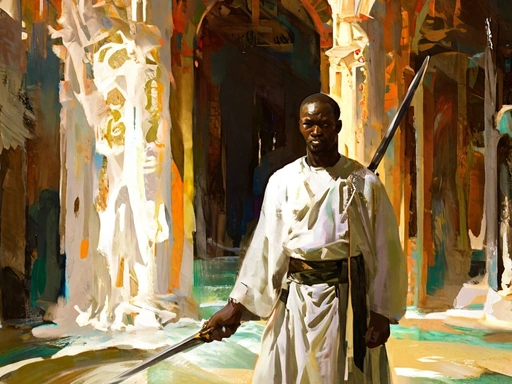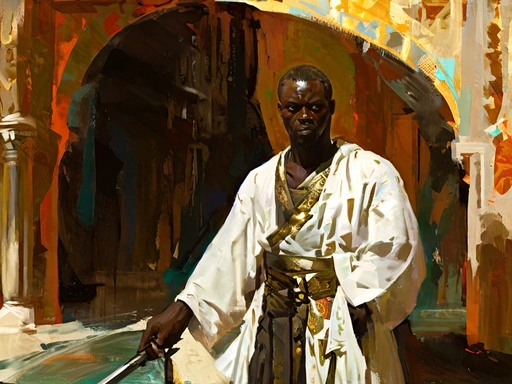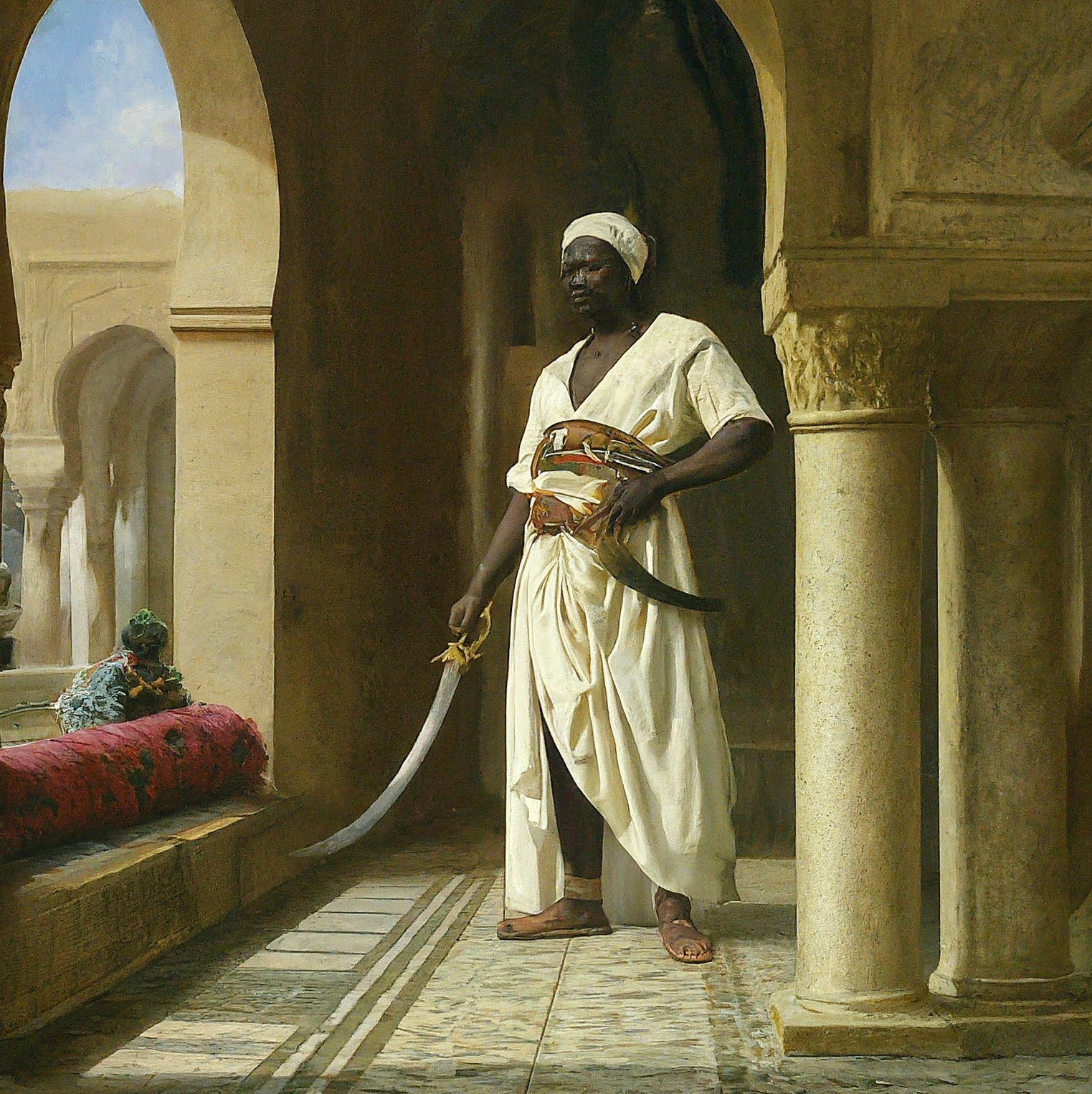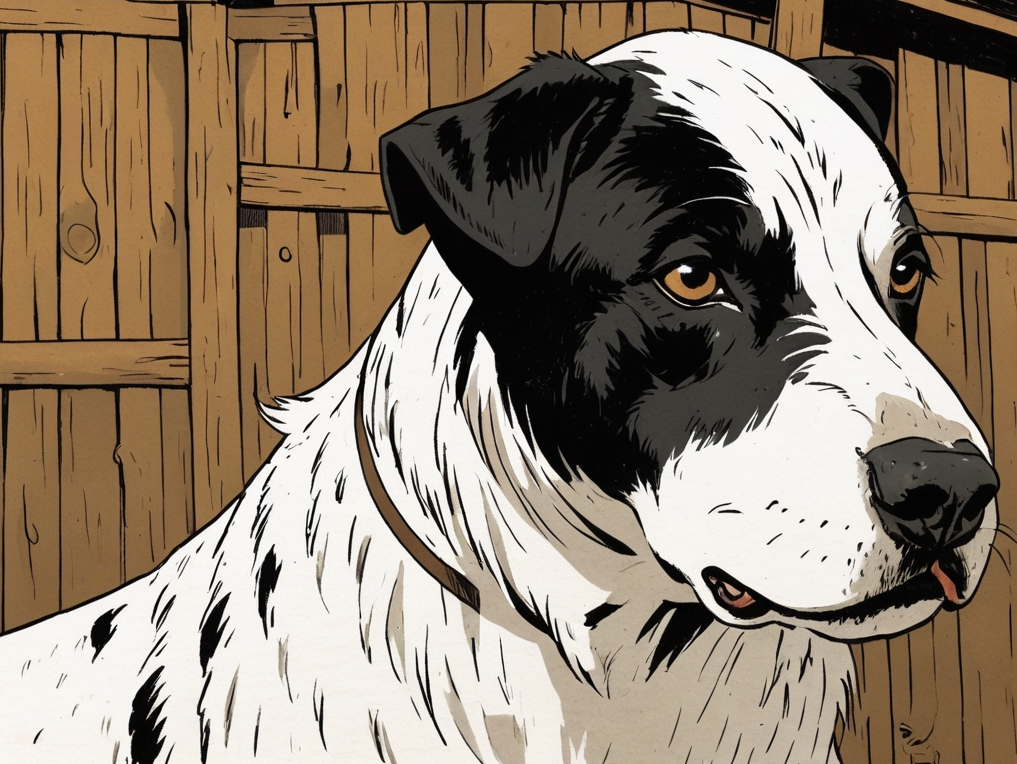Some may have noticed a deep dive into AI art posted in the SolAARium recently.
After some debate, the thought was some of this discussion should move out of the SolAARium and into the general forum. But as @Lord Durham noted in that discussion, this thread shouldn’t be just for posting pretty pictures. The concept here is to post some of your art to help instruct others about prompting and the use of different AI image generators. Perhaps there should be an interchange of ideas here.
So let me kick this off by further discussing some of the art in that SolAARium post and expand a bit on what was discussed there. (The ethical part of that discussion is still going on there, and it has expanded to cover AI not only for making images, but also music and writing AARs too.)
Getting AI to work for you in your AAR boils down to using words as prompts to get the AI to make the images. In that post, I glossed over how I had created one piece of art for the latest chapter in my AAR.
For those who are interested, here’s more of a general step-by-step approach. My platform of choice is Playground. So I go there and pick the Stable Diffusion XL image generator. I can choose several different image generators but this is the one I like best. Then I punch in this for the prompt: “A large African man, six and a half feet tall, who is a guard armed with a scimitar dressed in a long flowing white robe painted in the Romantic style of Danish artist J. L. Lund.”
I use the filter style: “Masterpiece” which adds a variety of additional items to the prompt.
I also use a negative prompt. For those who don’t know, a negative prompt supposedly stops items from appearing. But it doesn’t always work. Here’s the negative prompt I used: “ugly, deformed, noisy, blurry, distorted, out of focus, bad anatomy, extra limbs, poorly drawn face, poorly drawn hands, missing fingers, nudity, nude.”
Here’s one of the better results of the four images produced:

Here’s a link to the work so you can see all the settings.
Not exactly what I asked for in the prompt. What’s that giant spear all about? Not to mention the disk hanging from his belt.
Five rounds later, I still don’t have what I want.
You can see from this link to my prompts, I have adjusted the main prompt and changed the filter to “royalistic” but it isn’t improving. What you see below is one of the best of the more than 20 images produced.

I decide to move onward to a different platform: Leonardo AI.
On Leonardo, I pick the Leonardo Diffusion image generator (there are various you may choose) and I pick the Digital Painting filter. However the links on Leonardo only take you to my finished image, not the prompts, so I will include a screenshot that shows you the information after the finished image. You can see I have expanded the prompt I’m using beyond what I used on Playground and greatly expanded the negative prompt too. Here is one of the first results:


Still not what I want. You’ll see after another round with Leonardo, I adjust the main prompt and the negative prompt.
The issue is the curved sword. Neither of these platforms wants to produce the sword.
Here’s what I tried on the last and final round, with the instructions following.


This is when I turned to Google’s experimental ImageFX. The problem with ImageFX is that if you don’t store the URLs of your images you can’t see the prompts. There’s no account with a bank of images like the other services offer. Sorry to say, I did not save the URLs in this experiment so you can’t see this with exactitude. However, I used a prompt similar to this:
“A large African man, six and a half feet tall, who is a guard armed with a curved half-moon-style sword, a scimitar, dressed in a long flowing white robe inside a beautiful Arab palace painted in the Romantic style of a Danish artist.”
This time, I get three possible images to use:



I decide I like the last one best and use it for the post.
However, in replicating this experiment in the preparation for this discussion, I find that ImageFX has improved its quality of what this prompt produces and two of the images are similar to this first round. These I can share with you along with their URLs so you can see how this works a bit more. Here are the two best, starting with this one:

Now, the second and likely the best of the lot:

For those who are new to AI art, you can see, this relates to playing with the words to get the right combination, along with finding filters and platforms that might work best for you.
Perhaps others will post some of their art and share their process so folks here in AARland can learn from our experiments.
After some debate, the thought was some of this discussion should move out of the SolAARium and into the general forum. But as @Lord Durham noted in that discussion, this thread shouldn’t be just for posting pretty pictures. The concept here is to post some of your art to help instruct others about prompting and the use of different AI image generators. Perhaps there should be an interchange of ideas here.
So let me kick this off by further discussing some of the art in that SolAARium post and expand a bit on what was discussed there. (The ethical part of that discussion is still going on there, and it has expanded to cover AI not only for making images, but also music and writing AARs too.)
Getting AI to work for you in your AAR boils down to using words as prompts to get the AI to make the images. In that post, I glossed over how I had created one piece of art for the latest chapter in my AAR.
For those who are interested, here’s more of a general step-by-step approach. My platform of choice is Playground. So I go there and pick the Stable Diffusion XL image generator. I can choose several different image generators but this is the one I like best. Then I punch in this for the prompt: “A large African man, six and a half feet tall, who is a guard armed with a scimitar dressed in a long flowing white robe painted in the Romantic style of Danish artist J. L. Lund.”
I use the filter style: “Masterpiece” which adds a variety of additional items to the prompt.
I also use a negative prompt. For those who don’t know, a negative prompt supposedly stops items from appearing. But it doesn’t always work. Here’s the negative prompt I used: “ugly, deformed, noisy, blurry, distorted, out of focus, bad anatomy, extra limbs, poorly drawn face, poorly drawn hands, missing fingers, nudity, nude.”
Here’s one of the better results of the four images produced:
Here’s a link to the work so you can see all the settings.
Not exactly what I asked for in the prompt. What’s that giant spear all about? Not to mention the disk hanging from his belt.
Five rounds later, I still don’t have what I want.
You can see from this link to my prompts, I have adjusted the main prompt and changed the filter to “royalistic” but it isn’t improving. What you see below is one of the best of the more than 20 images produced.
I decide to move onward to a different platform: Leonardo AI.
On Leonardo, I pick the Leonardo Diffusion image generator (there are various you may choose) and I pick the Digital Painting filter. However the links on Leonardo only take you to my finished image, not the prompts, so I will include a screenshot that shows you the information after the finished image. You can see I have expanded the prompt I’m using beyond what I used on Playground and greatly expanded the negative prompt too. Here is one of the first results:

Still not what I want. You’ll see after another round with Leonardo, I adjust the main prompt and the negative prompt.
The issue is the curved sword. Neither of these platforms wants to produce the sword.
Here’s what I tried on the last and final round, with the instructions following.

This is when I turned to Google’s experimental ImageFX. The problem with ImageFX is that if you don’t store the URLs of your images you can’t see the prompts. There’s no account with a bank of images like the other services offer. Sorry to say, I did not save the URLs in this experiment so you can’t see this with exactitude. However, I used a prompt similar to this:
“A large African man, six and a half feet tall, who is a guard armed with a curved half-moon-style sword, a scimitar, dressed in a long flowing white robe inside a beautiful Arab palace painted in the Romantic style of a Danish artist.”
This time, I get three possible images to use:
I decide I like the last one best and use it for the post.
However, in replicating this experiment in the preparation for this discussion, I find that ImageFX has improved its quality of what this prompt produces and two of the images are similar to this first round. These I can share with you along with their URLs so you can see how this works a bit more. Here are the two best, starting with this one:
Now, the second and likely the best of the lot:
For those who are new to AI art, you can see, this relates to playing with the words to get the right combination, along with finding filters and platforms that might work best for you.
Perhaps others will post some of their art and share their process so folks here in AARland can learn from our experiments.
Last edited:
- 3
- 2











